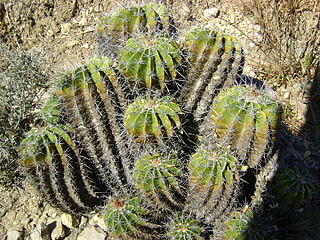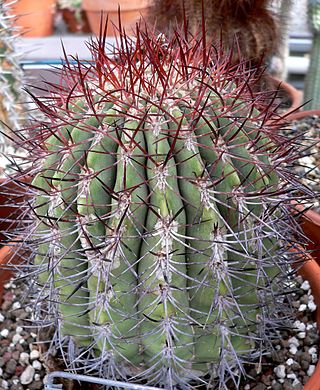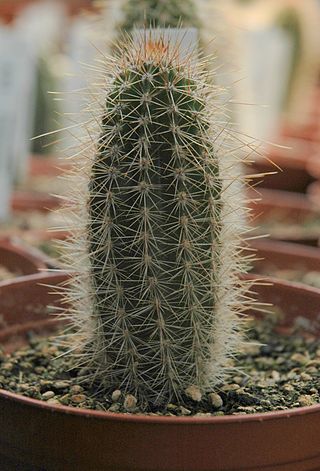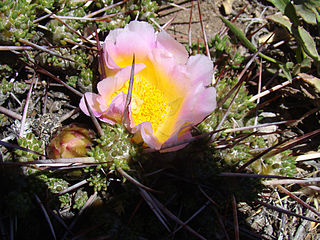
Neoraimondia is a genus of medium to large cacti from Peru. The genus is named after the Italian-born Peruvian explorer, naturalist, and scientist, Antonio Raimondi.

Mila caespitosa is a species of cacti and the only species of the genus Mila. Its generic name is an anagram of Lima, Peru, the city near which the plant is found. The genus was first thought to comprise 13 species, until recent studies suggest they form one very variable species.

Ferocactus robustus is a barrel cactus in the genus Ferocactus of the family Cactaceae.

Gymnocalycium anisitsii is a globular cactus belonging to the family Cactaceae. The specific epithet honors the Hungarian pharmacist Dániel Anisits J. (1856-1911).

Lobivia cinnabarina is a species of cactus first described in 1885.

Thelocactus rinconensis, synonyms including Thelocactus nidulans, is a species of cactus. It is endemic to north-east Mexico.

Ferocactus flavovirens is a species of Ferocactus from Mexico.

Denmoza is a monotypic genus of cacti. Its only species, Denmoza rhodacantha, is native to northwest Argentina.

Armatocereus cartwrightianus is a species of Armatocereus from Ecuador and Peru.

Armatocereus godingianus is a species of Armatocereus from Ecuador and Peru.

Lobivia ferox, is a species of Lobivia found in Bolivia and Argentina.

Lobivia pentlandii, is a species of Lobivia found in Bolivia and Peru.

Lobivia pampana is a species of Lobivia found in Peru.

Maihuenia patagonica, commonly known locally as chupasangre or siempre verde, is a succulent cactus shrub native to Chile and Argentina. Maihueniapatagonica is remarkably tolerant to moisture and cold temperatures.

Melocactus bahiensis is a species of Melocactus found in Bahia, Brazil.

Matucana haynii is a species of Matucana found in Peru.

Oroya peruviana is a species of cacti, originating from Peru.

Pelecyphora chihuahuensis is a species of flowering plant in the family Cactaceae, native to Mexico.

Ferocactus johnstonianus is a species of Ferocactus found in Mexico

Echinocereus scopulorum is a species of cactus native to Mexico.






















